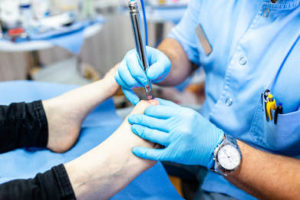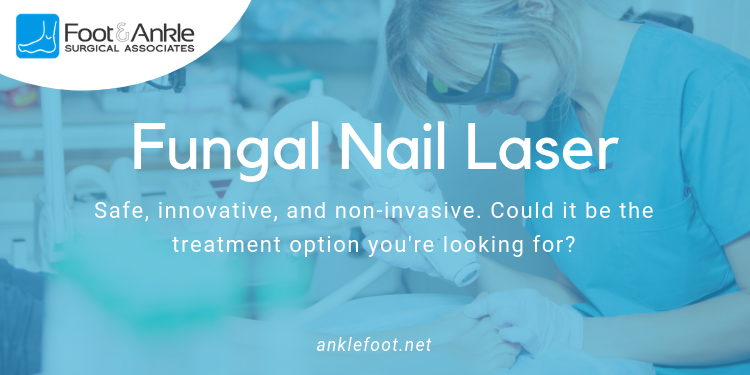Toenail fungus has a well-earned reputation as one of the most frustrating and irritating commonly contracted conditions.
Is it dangerous? No, not usually—at least not for most relatively healthy individuals.
But the sight of yellowed and ugly toenails can be deeply embarrassing for men and women of all ages. It can make you feel like banishing your sandals to the back of the closet forever, and keep you from enjoying time out in the sun.
And if you want to get rid of them? For starters, the condition absolutely does not go away on its own. You can’t wait it out. Beyond that, traditional treatments (which are all the most podiatric clinics can offer) for fungal toenails have a spotty track record at best, for reasons we’ll get to in a moment.
Recurrence rates are high, too.
It’s no wonder so many people simply give up.
But fortunately for you, there’s a newer, better way to deal with fungal toenails. Laser treatment has totally outclassed all previous treatments, making the whole process safer, faster, more convenient, and more successful than ever before.
But in order to understand just how incredible it is, you need to know a few things about the older, traditional treatments.
Traditional Remedies Had Some Major Drawbacks
When it comes to treating fungal infections under the toenails, there are some significant obstacles that you have to try to work around.
- The nail itself provides a very resistant natural barrier. Once the fungi get underneath, not only does it supply all the keratin they need to thrive, but it also does a great job keeping topical antifungal sprays, ointments, and powders out.
- Because your toes get a much lower quality of circulation than other parts of your body—even in healthy people—oral antifungals aren’t as effective as they otherwise could be. It generally takes a minimum of 6 weeks of daily pills for this route to be effective, and sometimes as many as 12.
Between the two options—internal vs external, if you will—oral antifungals have the best track record and are the most widely used in podiatry clinics today. But cure rates are still relatively spotty—perhaps 75 to 80 percent (good but not great), with lower odds the older you get.
Worse, oral antifungals can be dangerous for some people to talk, and can produce several undesirable side effects (including liver damage).
Topical treatments can also work, but they take a long time. Most people need to apply medication every day, and thin their nails at least once per week for an entire year to see results.
With discipline, it’s doable. But again, it’s not really surprising that so many people fail to follow through, either.
A Newer, Better Way
So what makes laser therapy so special? Just about everything, that’s what!
But first, how does it work?
Well, consider the fact that light is a form of energy. And that energy can be focused in different ways, with different properties (wavelength, power, pulse rate, etc.).
The laser we use to treat fungal toenails has been designed to harness that light energy to eradicate the unwanted fungi, as well as increase circulation to the affected area. This brings more oxygen, carries away more waste products, and leads to quicker healing of infected tissues. In other words, laser therapy not only kills the fungi, but can clear and heal the damaged tissue faster.
There are several huge advantages to using this new type of therapy.
- It’s more effective. Although no treatment method is perfect in all cases, we’ve found the overall success rate of laser treatment around 90 percent. That is notably higher than oral treatments alone, and significantly higher than topical treatments.
- It’s way more convenient. Oral treatments require up to 12 weeks of daily pills. Topicals can take a year or more. The toenail laser typically requires three or four office appointments spread out over a couple of months, each no more than 30 minutes in length. No contest.
- It’s 100% drug free. You don’t need to take any pills or apply any creams or medicines. You don’t even need anesthesia.
- It’s safe. As we said, oral antifungal medications in particular can lead to complications—some potentially serious. But laser therapy has not been shown to produce any negative consequences or complications whatsoever. No pain, no collateral damage to healthy tissue, nothing.
If you’ve decided long ago that you’re just going to live with your fungal toenails—whether that was because you were discouraged by your doctor, or the treatments you tried failed—there has never been a better time to seek out help.
Laser treatment is the best method we’ve ever had for clearing up a stubborn fungal toenail and helping patients get their confidence back.
And if you schedule your appointment now, the damaged parts of your toenail should have time to completely grow out over the winter—leaving them clear and ready to rock by the time sandal weather is back in the Pacific Northwest!
Interested? We thought so! To schedule your appointment at one of our convenient locations, give us a call today at (360) 754-3338.




